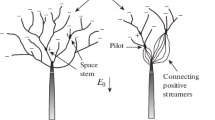Abstract
Physical arguments about the possible mechanism of formation of a leader channel are presented. A mathematical model describing steady-state leader breakdown is constructed. An algorithm for determining the propagation velocity, dimensions, and electric field in the streamer zone is developed. A numerical simulation of the channel formation stage in the plasma of a streamer zone a nitrogen atmosphere is performed. The dependence of the leader velocity on the potential is obtained. The tentative model proposed here can be used to describe the leader breakdown of a long gap at high positive potentials.
Similar content being viewed by others
References
Yu. P. Raizer, Physics of Gas Discharge [in Russian] (Nauka, Moscow, 1987), 591 pp.
M. V. Kostenko (Ed.), High-Voltage Technique [in Russian] (Vysshaya Shkola, Moscow, 1973), 351 pp.
É. M. Bazelyan and A. Yu. Goryunov, Elektrichestvo, No. 11, pp. 27–33 (1986).
A. É. Bazelyan and É. M. Bazelyan, Teplofiz. Vys. Temp. 32, 354 (1994).
A. V. Ivanovskii, Zh. Tekh. Fiz. 65(12), 48 (1995) [Tech. Phys. 40, 1230 (1995)].
É. M. Bazelyan and I. M. Razhanskii, Spark Discharge in Air [in Russian] (Nauka, Novosibirsk, 1988), 164 pp.
Ya. B. Zel’dovich and Yu. P. Raizer, Physics of Shock Waves and High-Temperature Hydrodynamic Phenomena, 2nd ed. [in Russian] (Fizmatgiz, Moscow, 1966), 686 pp.
N. L. Aleksandrov, A. M. Konchakov, and É. E. Son, Fiz. Plazmy 4, 169 (1978) [Sov. J. Plasma Phys. 4, 98 (1978)].
I. Shimamura, Sci. Pap. Inst. Phys. Chem. Res. (Jpn.) Vol. 82, pp. 1–51 (1989).
E. Gerjuoy and S. Stein, Phys. Rev. 97, 1671 (1955).
E. Gerjuoy and S. Stein, Phys. Rev. 98, 1848 (1955).
G. J. Schulz, Phys. Rev. 135, A988 (1964).
W. L. Borst, Phys. Rev. A 5, 648 (1972).
P. N. Stanton and R. M. St. John, J. Opt. Soc. Am. 59, 252 (1969).
A. E. S. Green and R. S. Stolarski, J. Atmos. Terr. Phys. 34, 1703 (1972).
D. Rapp and P. Englander-Golden, J. Chem. Phys. 42, 4081 (1965).
A. V. Eletskii and B. M. Smirnov, Usp. Fiz. Nauk 136, 254 (1982) [Sov. Phys. Usp. 25, 13 (1982)].
J. D. Lambert, Vibrational and Rotational Relaxation in Gases (Oxford, Clarendon Press, 1977).
V. S. Éngel’sht and B. A. Uryukov (Eds.), Low-Temperature Plasma. Theory of the Column of an Electric Arc [in Russian] (Nauka, Novosibirsk, 1990), 215 pp.
L. G. H. Huxley and R. W. Crompton, The Diffusion and Drift of Electrons in Gases (Wiley, New York, 1974); Mir, Moscow, 1977, 672 pp.
B. Sherman, J. Math. Anal. Appl. 1, 342 (1960).
Additional information
Zh. Tekh. Fiz. 68, 37–44 (June 1998)
Rights and permissions
About this article
Cite this article
Ivanovskii, A.V. Steady-state leader breakdown. Nitrogen atmosphere. Tech. Phys. 43, 648–654 (1998). https://doi.org/10.1134/1.1259047
Received:
Issue Date:
DOI: https://doi.org/10.1134/1.1259047




